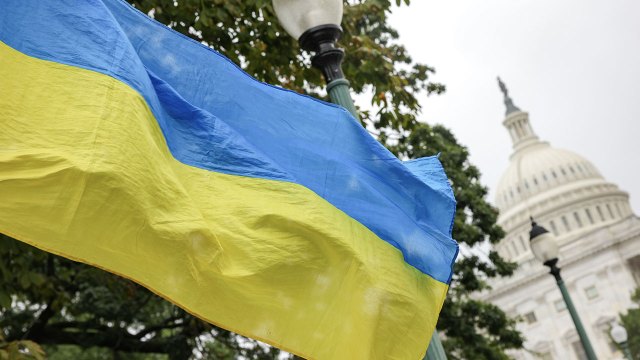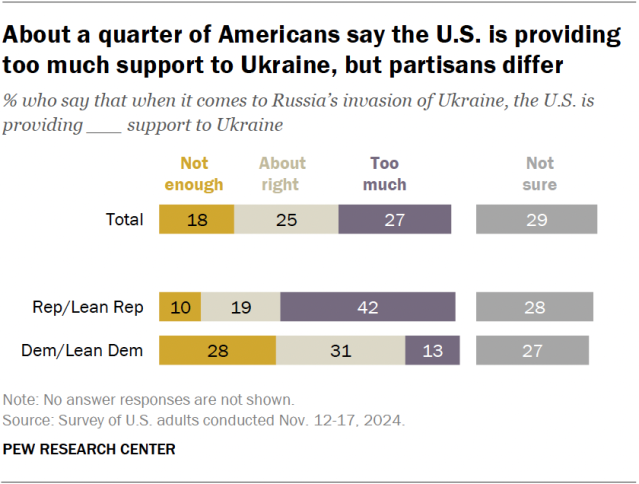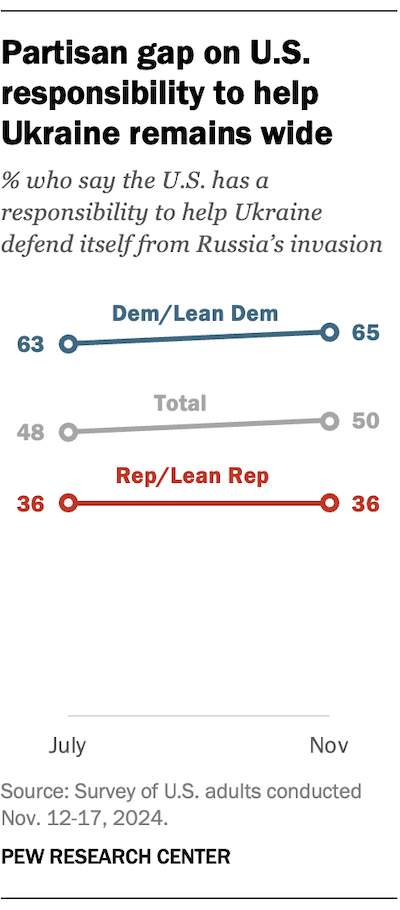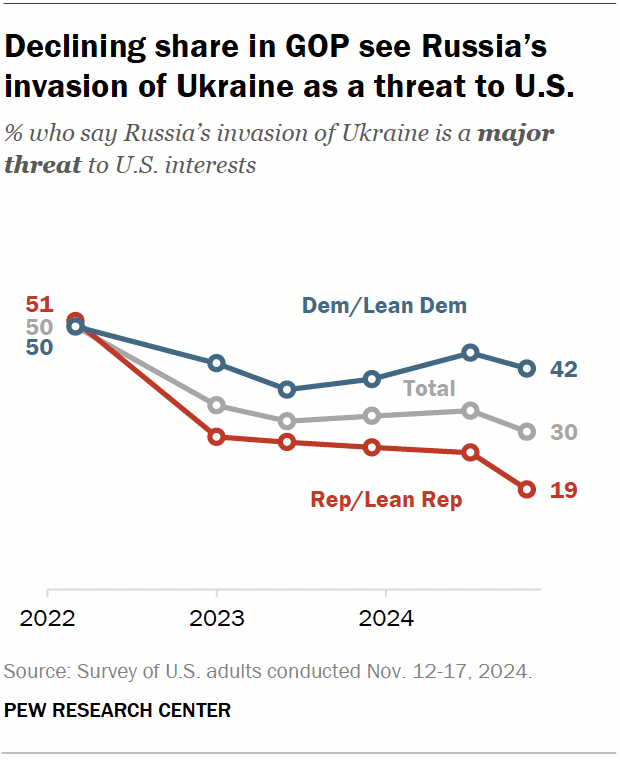Wide partisan divisions remain in Americans’ views of the war in Ukraine (original) (raw)
- Short Reads
|
November 25, 2024

A Ukrainian flag flies near the U.S. Capitol in Washington, D.C., on Sept. 25, 2024. (Bryan Dozier/Anadolu via Getty Images)
Nearly three years into the war in Ukraine, President-elect Donald Trump has been promising a swift end to the conflict when he takes office. Americans’ views about U.S. support for Ukraine have shifted little in recent months, but there continue to be wide partisan differences, according to a Pew Research Center survey conducted Nov. 12-17.
- Republicans are far more likely than Democrats to say the United States is providing too much support to Ukraine (42% vs. 13%).
- Republicans are also far less likely than Democrats to say the U.S. has a responsibility to help Ukraine defend itself against Russia’s invasion (36% vs. 65%).
Pew Research Center conducted this survey to assess Americans’ attitudes about the war in Ukraine. We surveyed 9,609 U.S. adults from Nov. 12 to 17, 2024.
Everyone who took part in this survey is a member of the Center’s American Trends Panel (ATP), a group of people recruited through national, random sampling of residential addresses who have agreed to take surveys regularly. This kind of recruitment gives nearly all U.S. adults a chance of selection. Surveys were conducted either online or by telephone with a live interviewer. The survey is weighted to be representative of the U.S. adult population by gender, race, ethnicity, partisan affiliation, education and other factors. Read more about the ATP’s methodology.
Here are the questions used for this analysis, along with responses, and its methodology.
In addition, Republicans and Republican-leaning independents have long been less likely than Democrats and Democratic leaners to see Russia’s invasion as a major threat to U.S. interests. But this partisan gap has grown. Just 19% of Republicans now say the invasion is a major threat, compared with 42% of Democrats.
Note: The survey was fielded before the Biden administration allowed Ukraine to use U.S. long-range weapons to hit targets inside Russia and provided anti-personnel mines to Ukraine.
U.S. support for Ukraine
Today, 27% of Americans say the U.S. is providing too much assistance to Ukraine. Another 25% characterize U.S. support as “about right,” and 18% say the U.S. is not providing enough support. These shares are similar to views in July, though Americans are now somewhat more likely to say they are not sure than they were four months ago (29% vs. 25% then).
- Among Republicans, 42% say the U.S. is providing too much support. Another 19% say the amount of support is about right, while one-in-ten say the U.S. is not providing enough support.
- By comparison, among Democrats, just 13% say the country is providing too much support to Ukraine. About three-in-ten (31%) say the level of support is about right. A similar share (28%) say the U.S. isn’t providing enough support.
U.S. responsibility to help Ukraine
Americans are also split on whether the U.S. has a responsibility to help Ukraine defend itself from Russia’s invasion. Half of Americans say the U.S. has this responsibility, while 47% say it does not. These views are largely unchanged over the last several months.
Partisans’ opinions are also essentially the same as they were in July:
- 36% of Republicans say the U.S. has a responsibility to help Ukraine defend itself. The same percentage said this in July.
- 65% of Democrats say the U.S. has this responsibility. That is also nearly identical to views in July (when 63% said this).
Russia’s invasion as a threat to U.S. interests
Three-in-ten Americans now say Russia’s invasion of Ukraine poses a major threat to U.S. interests. These views have been relatively stable over the last few years – though Americans were considerably more likely to say this in the early weeks of the conflict in 2022.
Since 2023, Republicans have been far less likely than Democrats to view the Russian invasion of Ukraine as a threat to the U.S. But the share saying this is now at a low point: Today, 19% say this, down from 26% in July.
About four-in-ten Democrats (42%) see Russia’s invasion as a major threat. This is slightly lower than the 45% who said this in July but on par with Democrats’ views since 2023.
Note: This is an update of a post originally published Jan. 31, 2023. Here are the questions used for this analysis, along with responses, and its methodology.


